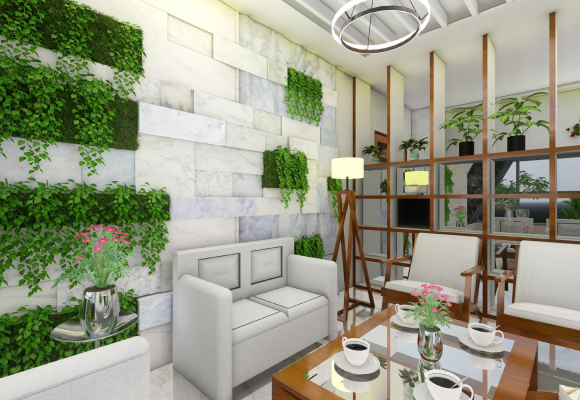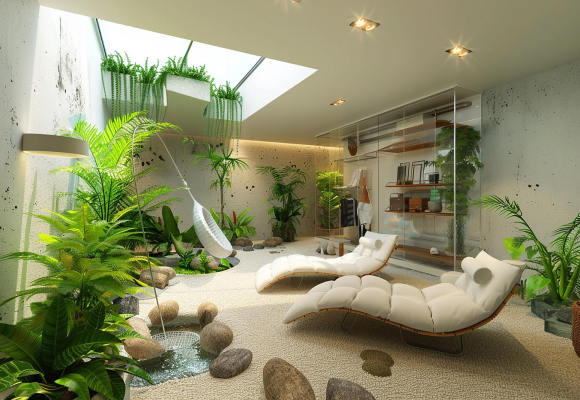- Residential Spaces: Biophilic design incorporated into the house will render the house spaces as spaces for retreat. Imagine a bedroom full of natural light, in earthy tones, with a view toward a lush garden; that is what biophilic interior design is.
- Office Spaces: Biophilic office design brings indoor plants, natural lighting, and organic materials into the work environment as a method of facilitating reduced stress and increased productivity. Incorporating green walls or indoor water features makes for a calming affect that helps employees to better focus on work.
- Hospitality Spaces: Hotels and resorts can benefit most from biophilic design through the creation of environments that present a feeling of contact with nature to their guests, furthering relaxation and rejuvenation. This may range from common area biophilic gardens to rooms using nature-inspired decor.
- Educational Spaces: Especially valued is the positive contribution that biophilic design can make to increased student learning outcomes. Bringing nature into the classrooms and common areas supports increased well-being, improved focus, and high academic performance of students.
- Commercial Spaces: Biophilic elements may be incorporated in retail stores, restaurants, and shopping malls to improve customer experiences by making the spaces more appealing and comfortable.
Biophilic Design
Biophilic Design
Biophilic design is other than a trend; it’s a certain philosophy that integrates nature into the immediate built environment, enhancing well-being, creativity, and productivity. Within the busy city of Dubai, where urban lives mostly displace us from nature, interior biophilic design offers a harmonious solution to bridge this gap and include nature’s calming essence in everyday spaces.

What is Biophilic Design?
Biophilic design is the concept that investigates our innate human connection with nature. It works by creating an atmosphere that reflects light, water, vegetation, natural materials, and landscapes. The word biophilia means love for living systems. With this incorporation of natural elements indoors, biophilic design increases our interaction with the natural world, hence boosting our mental and physical health.
Key Elements of Biophilic Design
| Element | Description |
|---|---|
| Natural Light | Maximizing sunlight exposure to improve mood and reduce stress. |
| Vegetation | Incorporating plants to purify air and bring greenery indoors. |
| Water Features | Using water elements like fountains or aquariums to create a calming ambiance. |
| Natural Materials | Utilizing wood, stone, and other organic materials to create a tactile connection with nature. |
| Views of Nature | Designing spaces with windows or wall murals that provide visual access to outdoor scenery. |
The Benefits of Biophilic Interior Design
Implementing biophilic design in your Dubai home or office can lead to a multitude of benefits:
- Enhanced Well-being: Views of nature shrink stress and anxiety through relaxing the human being.
- Increased Productivity: Design for biophilic offices has been proven through numerous studies to enhance creativity and productivity by creating an intellectually stimulating environment.
- Improved Air Quality: Incorporating plants into interior spaces will purify the air by removing toxins, improving indoor air quality in general.
- Sustainability: Biophilic design principles often align with sustainable practices, reducing energy consumption through natural lighting and temperature regulation.
| Design Element | Productivity Increase (%) |
|---|---|
| Natural Light | 15% |
| Access to Nature Views | 10% |
| Indoor Plants | 8% |
| Natural Materials | 5% |
Biophilic Design in Different Spaces
Biophilic design can be adapted to various settings: from the home environment to the office, hotel, and gym, ending with educational institutions. Here’s how biophilic concepts can transform different environments:

FAQs
Biophilic design is an approach that incorporates natural elements into architecture and interior design to create spaces that connect people with nature, improving well-being and productivity.
The key elements include natural light, vegetation, water features, natural materials, and views of nature.
Biophilic design can increase productivity, enhance employee well-being, and create more inviting and comfortable spaces for customers, leading to improved business outcomes.
Yes, biophilic design often aligns with sustainable practices by reducing energy consumption and promoting the use of natural, renewable materials.
Yes, biophilic design is versatile and can be adapted to various environments, including homes, offices, hotels, gyms, and educational institutions.
Contact Art Waves Today
Whether you’re looking to transform your home, office, or commercial space, our team of experts is here to help. Ready to embrace the benefits of biophilic design? Contact Art Waves for a consultation or to view our portfolio of completed projects. Let’s create a space that connects you with nature and enhances your well-being. Contact Us Today
